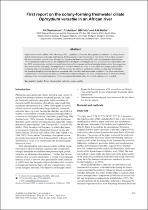 ResearchSpace
ResearchSpace
First report on the colony-forming freshwater ciliate Ophrydium versatile in an African river
JavaScript is disabled for your browser. Some features of this site may not work without it.
- ResearchSpace
- →
- Research Publications/Outputs
- →
- Journal Articles
- →
- View Item
| dc.contributor.author |
Oberholster, Paul J

|
|
| dc.contributor.author |
Ashton, PJ

|
|
| dc.contributor.author |
Fritz, GB

|
|
| dc.contributor.author |
Botha, AM

|
|
| dc.date.accessioned | 2010-08-24T13:01:01Z | |
| dc.date.available | 2010-08-24T13:01:01Z | |
| dc.date.issued | 2010-04 | |
| dc.identifier.citation | Oberholster, P.J., Ashton, P.J., Fritz, G.B. and Botha, A.M. 2010. First report on the colony-forming freshwater ciliate Ophrydium versatile in an African river. Water SA, Vol. 36(3), pp 315-321 | en |
| dc.identifier.issn | 0378-4738 | |
| dc.identifier.uri | http://hdl.handle.net/10204/4206 | |
| dc.description | Copyright: 2010 Water Research Commission | en |
| dc.description.abstract | Ophrydium versatile (Müller 1786) Ehrenberg 1830 – a symbiotic ciliate that forms gelatinous colonies – is widely distributed in temperate lakes in Europe and America, but has not previously been recorded from rivers. In this paper we report the first record of O. versatile in an African river, based on an identity confirmed by molecular taxonomic identification. The limnological conditions within the Lephalala River during the sampling period were characterised as oligotrophic with low DOC concentrations, similar to the conditions observed in temperate northern hemisphere lakes where these organisms have been recorded previously. The majority of O. versatile colonies occurred in areas where thin orange-coloured films containing high concentrations of iron (> 60% Fe) covered the substrate and bedrock of the river; this may be related to the abundant picophytoplankton that were associated with these films and oligotrophic conditions. The planktonic diatom Gomphonema venusta Passy was dominant in the water column throughout the study period and acted as an environmental indicator of low electrical conductivity (EC) conditions in the habitat where O. versatile colonies were recorded | en |
| dc.language.iso | en | en |
| dc.publisher | Water Research Commission | en |
| dc.subject | Lapalala River | en |
| dc.subject | Oligotrophic indicator | en |
| dc.subject | Water quality | en |
| dc.subject | Ophrydium versatile | en |
| dc.subject | African river | en |
| dc.title | First report on the colony-forming freshwater ciliate Ophrydium versatile in an African river | en |
| dc.type | Article | en |
| dc.identifier.apacitation | Oberholster, P. J., Ashton, P., Fritz, G., & Botha, A. (2010). First report on the colony-forming freshwater ciliate Ophrydium versatile in an African river. http://hdl.handle.net/10204/4206 | en_ZA |
| dc.identifier.chicagocitation | Oberholster, Paul J, PJ Ashton, GB Fritz, and AM Botha "First report on the colony-forming freshwater ciliate Ophrydium versatile in an African river." (2010) http://hdl.handle.net/10204/4206 | en_ZA |
| dc.identifier.vancouvercitation | Oberholster PJ, Ashton P, Fritz G, Botha A. First report on the colony-forming freshwater ciliate Ophrydium versatile in an African river. 2010; http://hdl.handle.net/10204/4206. | en_ZA |
| dc.identifier.ris | TY - Article AU - Oberholster, Paul J AU - Ashton, PJ AU - Fritz, GB AU - Botha, AM AB - Ophrydium versatile (Müller 1786) Ehrenberg 1830 – a symbiotic ciliate that forms gelatinous colonies – is widely distributed in temperate lakes in Europe and America, but has not previously been recorded from rivers. In this paper we report the first record of O. versatile in an African river, based on an identity confirmed by molecular taxonomic identification. The limnological conditions within the Lephalala River during the sampling period were characterised as oligotrophic with low DOC concentrations, similar to the conditions observed in temperate northern hemisphere lakes where these organisms have been recorded previously. The majority of O. versatile colonies occurred in areas where thin orange-coloured films containing high concentrations of iron (> 60% Fe) covered the substrate and bedrock of the river; this may be related to the abundant picophytoplankton that were associated with these films and oligotrophic conditions. The planktonic diatom Gomphonema venusta Passy was dominant in the water column throughout the study period and acted as an environmental indicator of low electrical conductivity (EC) conditions in the habitat where O. versatile colonies were recorded DA - 2010-04 DB - ResearchSpace DP - CSIR KW - Lapalala River KW - Oligotrophic indicator KW - Water quality KW - Ophrydium versatile KW - African river LK - https://researchspace.csir.co.za PY - 2010 SM - 0378-4738 T1 - First report on the colony-forming freshwater ciliate Ophrydium versatile in an African river TI - First report on the colony-forming freshwater ciliate Ophrydium versatile in an African river UR - http://hdl.handle.net/10204/4206 ER - | en_ZA |





